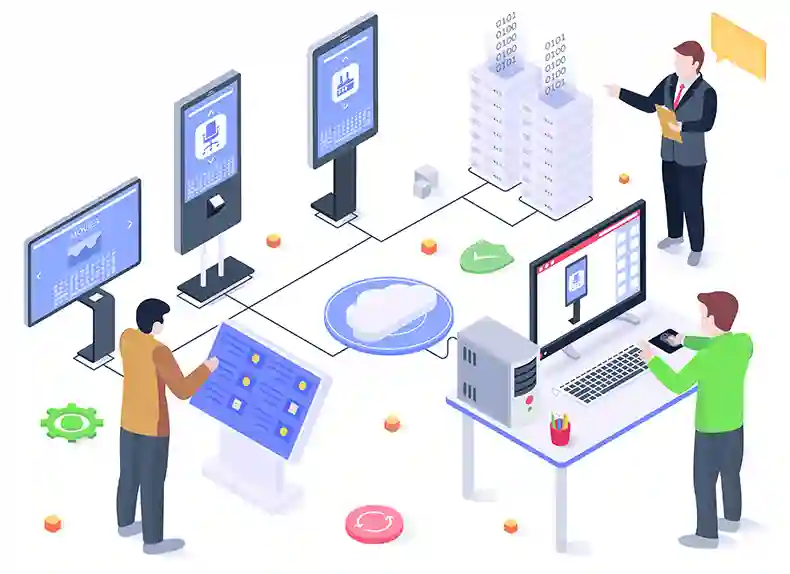Headless CMS Use Case: Digital Signage

Amanda Jones

The dazzling billboards illuminating Times Square are more than powerful advertisements for leading brands. They’re a prime example of what is possible with digital signage solutions. For a market projected to reach $33 billion in 2023, digital signage displays are precious.
While every enterprise doesn’t need its name plastered across skyscrapers, digital signage can still be useful for many different situations. Even though it might be tempting to opt for specialized digital signage software, a headless CMS can provide more flexibility and be used for several other use cases, including delivering content to digital signage. In this article, we’ll explain how it can be the optimal tool for powering content experiences on digital screens, smart TVs, and the like.
The Digital Signage Revolution
Digital signage software is used to display content on electronic screens. But it isn’t just restricted to the billboards people living in major cities around the world will come across. Digital signage includes screens in airports and train stations, restaurant menus, digital mall kiosks, and several other use cases. The future of digital signage is ripe with opportunities for enterprises to engage with customers, employees, the public, and all stakeholders.
Replacing Physical Signs
These signs can be used to display marketing messages or relevant customer information and provide a newfound way to enhance the customer experience. For example, the American Superbike Racing Association (ASRA) hosts regular events at closed-circuit motorsports parks.
In an environment like this, with countless moving parts, loud noises, and other distractions, physical signs standing on the ground can easily get lost. So how can the ASRA ensure that there are no communication issues? With digital signage.
Watch: Digital Signage on CrafterCMS and React
Powering Dynamic Experiences
Along with practical use cases like this, enterprises should pay attention to digital signage trends related to the overall customer journey. With the evolution of content management capabilities and the explosion of artificial intelligence, digital signage doesn’t only need to be used to display static messages. It can also be used for presenting interactive holograms and immersive experiences.
It can also be part of a dynamic buying experience that displays personalized and relevant information to consumers at the right time. For example, stores in malls can use digital signage to showcase product walkthroughs, highlight current inventory levels for items that are proving popular and other activities to enhance the customer experience.
What Makes a Headless CMS Ideal For Digital Signage Software
Companies needing digital signage software often think they need a specialized software tool to display content in this way. However, with the flexibility of a headless CMS, brands can launch content experiences without digital signage software and repurpose and reuse that content on other channels. Here’s why a headless CMS fits the digital signage bill:
No Restrictions on the Presentation Layer
A headless CMS doesn’t only restrict you to delivering content to one channel. With specialist digital signage software, the content will be displayed on that digital sign, but you would still need a CMS to push content to websites, mobile devices, and other channels. A headless CMS offers increased reach, no matter where content must be delivered.
Omnichannel Content Delivery
With a headless CMS, content doesn’t only get sent to multiple channels, but you can create an omnichannel content experience. In this case, customers who interact with the brand can be guaranteed the same consistent experience, regardless of the previous channel which they toggled from. Internally, it also means that content teams can see the entire customer journey from one central hub.
Reduced Complexity
A headless CMS can reduce the complexity of managing multiple software solutions. It also removes the need to have multiple traditional CMSs, which some enterprises often resort to accomplish the multi-channel content delivery a headless CMS provides natively.
Cost Savings
With fewer moving parts to manage, since they can use a single headless CMS instead of multiple solutions, businesses can reduce their overhead and the excess spending that might occur from added licensing, implementation, and maintenance costs.
Ease of Use
A modern headless CMS doesn’t just provide freedom and flexibility to developers; it also provides the traditional content management tooling that marketing teams are accustomed to. This means updating digital signage is easier and doesn’t require businesses to consult specialist teams whenever they have a new campaign.
Improved Flexibility
With traditional digital signage software, enterprises are often restricted to static messaging displays. With a headless CMS, it’s possible to pull relevant data from other systems in the technology stack, such as CRMs and other data management systems. This allows businesses to incorporate elements of personalization and localization to further enhance the digital signage experience.
CrafterCMS: The Answer to Digital Signage…And More
Enterprises don’t need to limit themselves to digital signage software that only manages content for that channel, forcing them to incur additional costs and providing a non-intuitive user experience.
CrafterCMS is a headless CMS built for the enterprise and provides everything necessary to create customer-centric digital experiences. CrafterCMS is the perfect solution for your digital signage needs and can deliver content to mobile kiosks, hotel lobbies, stadium screens, live event experiences, and everything in between.
Crafter Studio offers user-friendly tools to create, update, and publish digital signs. This includes a drag/drop experience builder, WYSIWYG content editor, multi-channel preview, and other features that make composing digital experiences as efficient as possible. Developers can build their digital signage apps any way they choose, as there are no restrictions on the presentation layer or frontend framework. Plus. CrafterCMS enables you to create digital experiences for other channels, including portals and intranets, modern corporate websites, eCommerce store frontends, AR/VR applications, OTT video experiences, and more.
With CrafterCMS, a digital signage solution can be as simple as creating a React.js application running in a browser on a smart TV or a computer driving the display(s). That application gets published to a digital sign using a headless API provided by CrafterCMS. What does that look like in action? Look at this walkthrough of our digital signage solution at the race track: Digital Signage on CrafterCMS and React.
Related Posts

Websites Are Dead?

Mike Vertal

No-Code Experience Building for Marketers & Designers

Amanda Lee

The Future of Web Experiences: From Browsing and Searching to Conversational AI

Mike Vertal

Is Your CMS MACH-Ready? A Practical Guide for Enterprise Architects

Sara Williams
Related Resources
-

CrafterCMS at eBay: The Universal Content Platform for eBay.com
Webcast
-

Personalized Digital Experiences for a Cruise Liner
Webcast
-

Introducing CrafterCMS v4.0
Webcast
-

Modernizing Video Delivery and Content Management at CPAC, A Canadian Nationwide Broadcaster
Webcast
-

Building React Apps on a Headless CMS
White Paper





